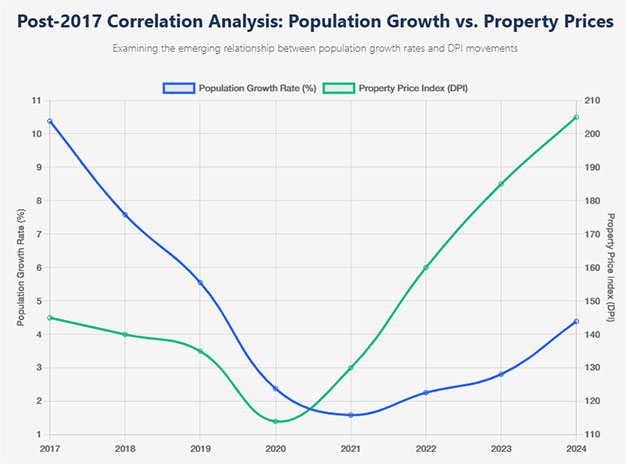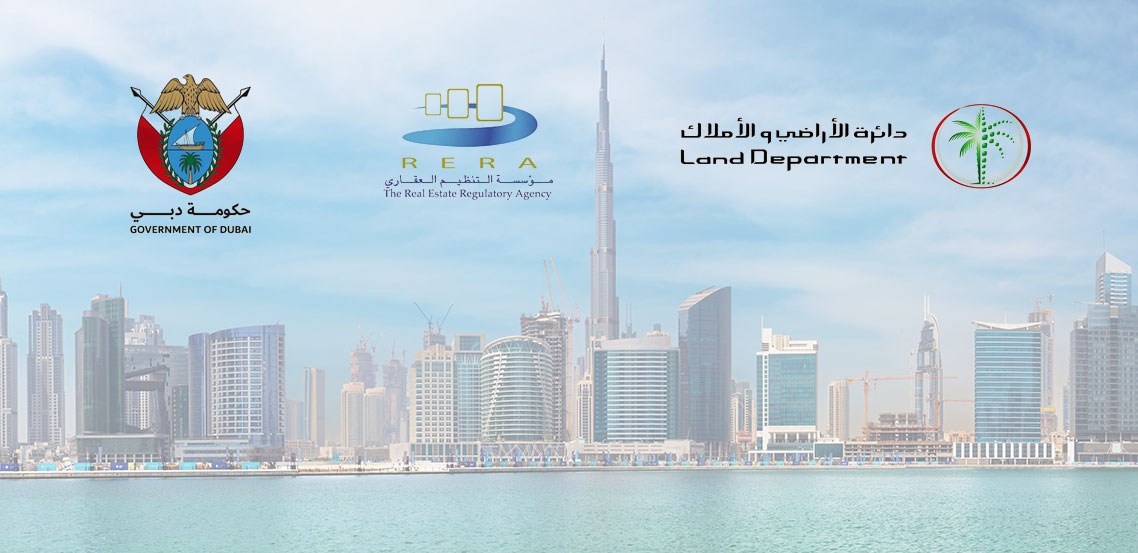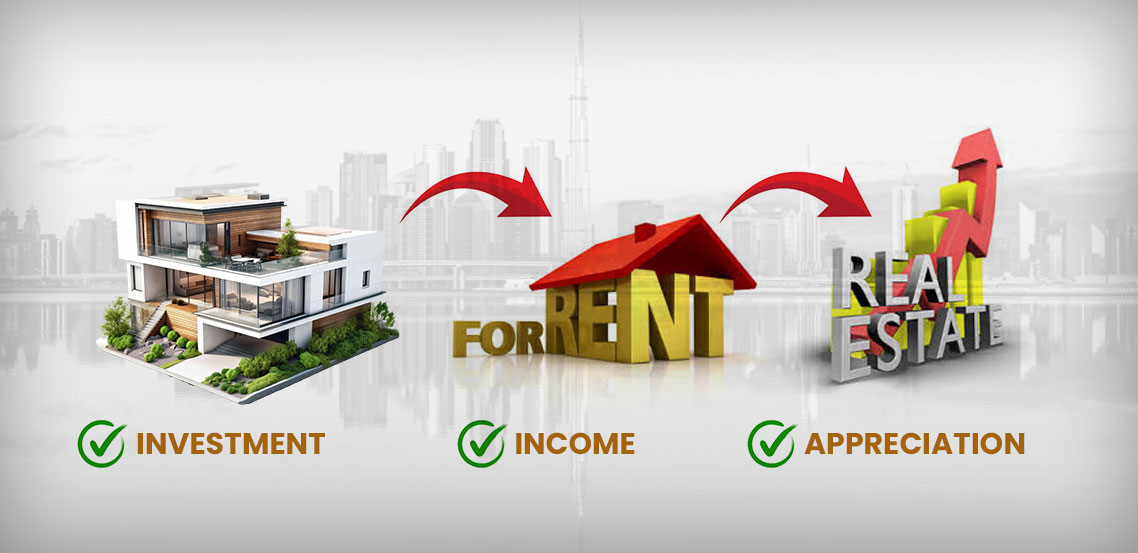
This is the often-asked question about any growing city of the world; and it becomes even more pertinent when the city in question is the one that has risen to unmatched heights within the shortest period of time – DUBAI THE CITY OF NEW DREAMS!
Historically Dubai’s real estate market has been a rollercoaster of soaring peaks and sudden dips from 2000 to 2020. However, the last 5 years saw continuous significant efforts by the Dubai and UAE government in addressing these volatility concerns and making Dubai the more investor-friendly market. On analysing the standard deviation of property price changes, we observe the volatility drop from 38.30% (2005-2011) to 22.11% (2012-2018), stabilizing at 23.27% (2019-2024).
Though still high on volatility in comparison to other mature markets like London, Singapore, etc., Dubai is clearly managing volatility, heading towards stability and consistent growth.
Growth and Stability is guided by 2 key factors:
Population Growth
Regulatory Control


In 2025, the population stands at 3.90 million, marking a significant increase from 2.90 million in year 2020, an astronomical growth close to 35% in 5 years.
This population growth is a critical driver of real estate demand. Analyzing the correlation between population growth and property prices post-2017 provides insights into market dynamics.
75% directional alignment between population growth rate changes and Dubai Property Price movements.
Market Maturity emergence of more predictable relationship between demographics and prices.
Recent population growth more closely tied to end-user demand rather than speculative investment.
Government policy initiatives aligning population growth with sustainable price appreciation.


Dubai Government has been keenly monitoring, managing and addressing each issue to ensure stabilisation of the real estate market here:
Regulated Off-Plan Sales: Stricter escrow account regulations ensure developers complete projects on time and protect investor funds.
Long-Term Residency (Golden Visa): Offering 10-year visas to property investors (minimum AED 2 million investment) has encouraged long-term commitment rather than short-term speculation.
Diversified Economy: Efforts to reduce reliance on oil, boost tourism, and attract global businesses help sustain property demand.
Controlled New Supply: Authorities like the Dubai Land Department (DLD) monitor new project launches to prevent excessive oversupply.
Focus on Demand-Driven Development: Developers are shifting toward mid-income housing and rental properties rather than just luxury segments.
Investor-Friendly Reforms: Introduction of freehold ownership for foreigners, digital real estate transactions, and transparent property registration have strengthened investor confidence.
Rental Regulations: The RERA rental index helps maintain fair rental pricing, preventing sudden hikes and ensuring tenant protection.
Loan-to-Value (LTV) Adjustments: The UAE Central Bank increased LTV ratios for first-time buyers, making homeownership more accessible.
Alternative Financing Options: Developers now offer post-handover payment plans and rent-to-own schemes to attract buyers without mortgage reliance.
Green Building Mandates: Dubai’s Green Building Regulations and Estidama in Abu Dhabi ensure new developments meet sustainability standards.
Smart City Investments: Heavy investment in AI-driven smart infrastructure, EV-friendly projects, and solar energy adoption supports long-term sustainability.
Public Transport Expansion: Dubai Metro, upcoming railway projects, and improved road networks enhance connectivity for new communities.

The proactive initiatives from the Dubai and UAE government have significantly impacted both investors and end-users in the real estate sector.
Investor confidence has been all-time high with 2024 recording 217,000 investments valued at AED526 billion, reflecting impressive growth rates of 38% volume and 27% in value.
BRICS (Brazil, Russia, India, China, and South Africa) Factor that is driving the growth of foreign capital inflows into the emirate. Noteworthy, Chinese and Russian nationals’ investments in Dubai’s luxury real estate market increased by 15% and 20% respectively in 2024.
China has become the third-largest source of foreign investment in Dubai’s real estate market after the UK and India. The UAE Golden Visa programme, which offers long-term residency to foreign investors, has been highly attractive to Chinese and Russian nationals, is a key driver. It offers them both investment opportunities and stability.
Dubai and UAE real estate developers are constantly innovating with multiple payment plan options. Whether it is the conventional 20/80 plan or the most innovative 1% per month plan or massive discounts up to 35% for cash buyers, the Dubai market has one plan to suit every investor/buyer.
Moreover, there are multiple extremely appealing add-on offers like free maintenance for 5 or 10 years, instant rental yield from developer or an assured buy-back offer in 10 years, etc. to attract immediate attention towards their respective property.
What is important to note is that all of these payment and add-on offers are all governed and cleared by regulatory bodies like the Dubai Land Department and the finance UAE Credit Bureau.
Dubai’s real estate market is witnessing a transformative shift towards sustainability, driven by government initiatives and increasing environmental awareness. Key policies like the UAE Net Zero 2050 and the Dubai 2040 Urban Master Plan are pushing developers to prioritize eco-friendly projects. This commitment is evident in sustainable communities like Dubai Sustainable City, which boasts energy-efficient buildings and advanced waste management systems.
The integration of renewable energy sources, such as the Mohammed bin Rashid Al Maktoum Solar Park, aligns with the Dubai Clean Energy Strategy 2050, aiming for 75% clean energy by 2050.
Additionally, LEED-certified buildings in Dubai, ranking third globally, exemplify the city’s leadership in green building practices. This not only reduces environmental impact but also enhances property values, making sustainable investments attractive to buyers.
The UAE Residential Real Estate Market size valued at around USD 36.32 Billion in 2024, is projected to reach USD 52.32 billion by 2030. So, UAE Investors & Buyers enjoying benefits of multiple options, sustainable infrastructure and regulated control will see a safe, protected, high yielding, stabilized real estate market growth from here on.